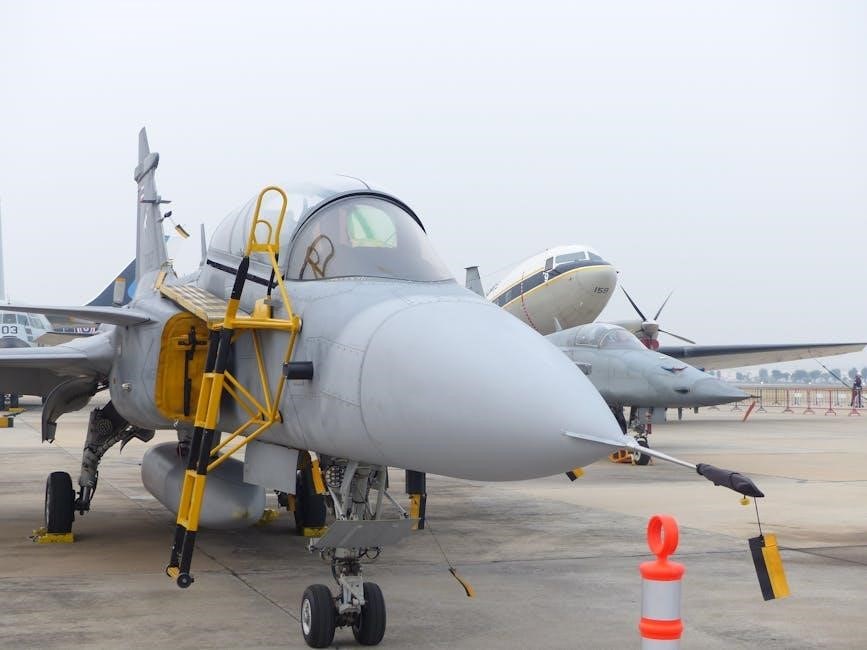Welcome to the Husqvarna YTH22V46 manual, your comprehensive guide to understanding and operating your lawn tractor. This 28-page manual covers operation, maintenance, and safety tips for optimal use.

1.1 Overview of the Husqvarna YTH22V46 Lawn Tractor
The Husqvarna YTH22V46 is a powerful and versatile lawn tractor designed for medium to large-sized lawns. Equipped with a 22 HP engine and a 46-inch cutting deck, it offers efficient mowing performance. The tractor features hydrostatic transmission for smooth operation and a comfortable seating design. It is ideal for homeowners seeking reliability and durability. This manual provides detailed guidance on operation, maintenance, and safety, ensuring you get the most out of your tractor while maintaining its longevity.
1.2 Purpose of the Manual
This manual is designed to provide comprehensive guidance for the Husqvarna YTH22V46 lawn tractor, ensuring safe and effective operation. It covers essential information on assembly, maintenance, troubleshooting, and proper usage. The manual also includes safety precautions, warranty details, and technical specifications to help users maximize their tractor’s performance. By following the instructions, users can maintain their tractor’s longevity and ensure optimal mowing results. This guide is a valuable resource for both new and experienced users, offering clear instructions and helpful tips for every aspect of tractor ownership.
1.3 Importance of Reading the Manual
Reading the Husqvarna YTH22V46 manual is crucial for safe and effective operation. It provides essential safety guidelines, operating instructions, and maintenance tips to ensure optimal performance. Understanding the manual helps users avoid accidents, prolong the tractor’s lifespan, and troubleshoot common issues. It also outlines warranty details and technical specifications, ensuring compliance with manufacturer recommendations. By following the manual, users can maximize efficiency, maintain their tractor properly, and enjoy a seamless mowing experience. This guide is indispensable for both new and experienced users to get the most out of their investment.

Safety Precautions and Guidelines
Always wear protective gear and follow safety guidelines to ensure safe operation. Be aware of your surroundings and keep bystanders away while operating the tractor.
2.1 General Safety Guidelines
Always read and understand the manual before operating the tractor. Wear protective gear, including gloves and eyewear. Ensure the area is clear of obstacles and bystanders. Never allow children to operate the tractor. Use the seatbelt when operating and avoid loose clothing. Keep the tractor in good working condition and follow all safety symbols. Be cautious on slopes and uneven terrain. Never leave the tractor unattended while it is running. Regularly inspect and maintain the tractor to ensure safe operation. Follow all local regulations and environmental guidelines.
2.2 Safety Symbols and Their Meanings
The manual uses specific safety symbols to alert users of potential hazards. These symbols include warnings, cautions, and notices. A warning indicates a potentially dangerous situation that could result in serious injury or death. A caution alerts users to situations that may cause minor injury or damage. A notice provides important information for safe and effective operation. Understanding these symbols is crucial for safe tractor operation. Refer to the manual for detailed explanations of each symbol and its meaning to ensure proper usage and adherence to safety guidelines.
2.3 Pre-Operation Safety Checks
Before operating the Husqvarna YTH22V46, perform essential safety checks. Ensure the parking brake is engaged and the PTO is disengaged. Check the seat switch and all control functions for proper operation. Verify that all safety shields and guards are in place. Inspect the mower deck for damage or obstructions. Ensure the area is clear of debris and obstacles. Always wear protective gear, including gloves and eyewear. Familiarize yourself with the tractor’s controls and ensure all systems function correctly before starting the engine. These checks are vital for safe and efficient operation.
Product Specifications
- Engine power: 22 HP Briggs & Stratton engine.
- Mower deck size: 46-inch cutting deck.
- Transmission: Hydrostatic for smooth operation.
- Fuel capacity: 2.5 gallons.
- Designed for medium-sized lawns with durability.
- Ergonomic design for comfort and efficiency.
3.1 Key Features of the YTH22V46
The Husqvarna YTH22V46 is a robust lawn tractor designed for efficient mowing. It features a powerful 22 HP Briggs & Stratton engine, a 46-inch cutting deck, and hydrostatic transmission for smooth operation. The tractor includes an ergonomic design with an adjustable seat and steering wheel, ensuring comfort during long mowing sessions. It also offers a convenient cruise control feature and a washout port for easy deck maintenance. With a fuel capacity of 2.5 gallons, it provides ample runtime for medium-sized lawns. These features make it a reliable choice for homeowners seeking durability and performance.
3.2 Technical Specifications
The Husqvarna YTH22V46 features a 22 HP Briggs & Stratton engine, providing reliable power for mowing. It has a hydrostatic transmission for smooth speed control and a 46-inch cutting deck with adjustable height settings. The tractor is equipped with a 2.5-gallon fuel tank, ensuring extended runtime. Additional specs include a robust steel frame, 20-inch rear tires, and a 15-inch steering wheel for precise control. The deck washout port simplifies maintenance, while the ergonomic design enhances comfort during operation. These specifications ensure optimal performance for medium-sized lawns.
3.4 Warranty Information
The Husqvarna YTH22V46 is backed by a comprehensive warranty program. The tractor is covered under a 5-year limited warranty, while the cutting deck is protected by a 3-year limited warranty. Proper maintenance, as outlined in this manual, is required to maintain warranty validity. For full warranty terms, including coverage details and exclusions, refer to the warranty section in this manual. Registration of your product is recommended to ensure seamless warranty service. This warranty reflects Husqvarna’s commitment to quality and customer satisfaction.
Assembly and Installation
Assembly involves unboxing, inventorying parts, and following step-by-step instructions. Ensure all components are correctly installed and adjusted. Purge the transmission before first use for smooth operation.
4.1 Unboxing and Inventory of Parts
Welcome to the assembly section! Start by carefully unboxing your Husqvarna YTH22V46 and inspecting for damage. Inventory all parts against the manual’s list to ensure completeness. Locate the tractor, keys, attachments, and hardware. Organize components to avoid misplacement. If any item is missing or damaged, contact Husqvarna support immediately. Proper inventory ensures a smooth assembly process. Take your time to verify each part before proceeding.
4.2 Step-by-Step Assembly Instructions
Begin by attaching the steering wheel using the provided hardware. Next, secure the seat to the tractor frame, ensuring all bolts are tightened properly. Attach the mower deck by aligning the mounting brackets and fastening with the included screws. Refer to the manual for specific torque values. Connect the deck lift lever and ensure it operates smoothly. Finally, install any additional accessories like the bagger or mulch kit. Double-check all connections and bolts for tightness before proceeding to the initial setup.
4.3 Initial Setup and Adjustments
After assembly, purge the transmission by slowly moving the tractor forward and backward. Adjust the mower deck height using the lift lever, ensuring it is level for even cutting. Check and inflate tires to the recommended pressure. Verify the oil and fluid levels, topping them off as needed. Test all controls, such as the throttle and brake, to ensure proper function. Finally, review the manual for any model-specific adjustments and ensure all safety features are operational before first use.

Operating the Tractor
Operating the Husqvarna YTH22V46 involves understanding controls, ensuring safety, and preparing the tractor for use. Start the engine, engage the mower, and adjust settings for optimal performance.
5.1 Starting the Engine
To start the engine of your Husqvarna YTH22V46, ensure the tractor is on a level surface and the parking brake is engaged. Move the mower deck to the “disengaged” position and set the throttle to the “choke” position. Insert the key into the ignition and turn it clockwise to start the engine. Allow the engine to warm up for a few seconds before adjusting the throttle to your desired speed. Always refer to the manual for specific starting procedures and safety precautions to ensure smooth operation.
5.2 Basic Operating Controls
The Husqvarna YTH22V46 features intuitive controls designed for ease of use. The steering wheel provides smooth directional control, while the foot pedals manage acceleration and braking. The control levers on the right side handle the mower deck lift and PTO (Power Take-Off) engagement. Always ensure the PTO switch is off when not mowing. Familiarize yourself with these controls to operate the tractor safely and efficiently. Refer to the manual for detailed instructions on adjusting and using these controls effectively during operation.
5.3 Mowing Techniques and Tips
For optimal mowing results with your Husqvarna YTH22V46, maintain a consistent mowing pattern and keep the mower deck at the recommended height. Always purge the transmission before first use. Mow in slightly overlapping passes to ensure even cutting. Avoid cutting more than one-third of the grass blade to promote healthy growth. Leave grass clippings on the lawn to act as a natural fertilizer. Adjust your speed according to grass thickness and use the PTO engage/disengage feature as needed. Proper techniques will enhance efficiency and lawn health.
Maintenance and Servicing
Regular maintenance ensures optimal performance. Check oil, fluids, and blades frequently. Refer to the manual for detailed schedules and procedures. Download the full manual for additional guidance.
6.1 Routine Maintenance Schedule
Regular maintenance is crucial for optimal performance and longevity. Check oil and fluid levels before each use, sharpen blades monthly, and purge the transmission annually. Every 50 hours, change the engine oil and inspect the air filter. Refer to the manual for a detailed schedule. Proper upkeep ensures safety and efficiency. Download the full manual for comprehensive guidance on maintaining your Husqvarna YTH22V46.
6.2 Oil and Fluid Checks
Regular oil and fluid checks are essential for maintaining your Husqvarna YTH22V46. Check the engine oil level before each use, ensuring it reaches the recommended level. Use SAE 30 or 10W-40 oil for optimal performance. Inspect the hydraulic fluid level using the dipstick and top it off if necessary. Refer to the manual for specific guidelines on fluid types and capacities. Proper fluid maintenance ensures smooth operation and extends the tractor’s lifespan. Download the full manual for detailed instructions on oil and fluid checks.
6.3 Blade Maintenance and Sharpening
Regular blade maintenance is crucial for optimal mowing performance. Inspect the blades for damage or wear and sharpen them as needed. Dull blades can tear grass, leaving it vulnerable to disease. Sharpen blades carefully, ensuring balance to maintain even cutting. Always disconnect the spark plug before performing blade maintenance. Refer to the manual for specific sharpening techniques and safety guidelines. Proper blade care extends the life of your tractor and ensures a clean, precise cut every time. Download the full manual for detailed blade maintenance instructions.
Troubleshooting Common Issues
This section helps you identify and resolve common issues with your Husqvarna YTH22V46 tractor, ensuring optimal performance and addressing problems like transmission issues or blade malfunctions effectively.
7.1 Common Problems and Solutions
Common issues with the Husqvarna YTH22V46 include transmission problems and blade malfunctions. For transmission issues, ensure proper purging before first use. Dull or damaged blades can cause poor cutting performance; sharpen or replace them as needed. Regular maintenance, such as oil checks and filter cleaning, prevents engine issues. If the tractor doesn’t start, check the ignition switch, fuel level, and air filter. Refer to the manual for diagnostic steps and solutions to ensure optimal performance and extend the tractor’s lifespan.
7.2 Diagnostic Techniques
Diagnosing issues with your Husqvarna YTH22V46 involves checking key components. Start by ensuring the ignition switch is functioning properly and the parking brake is engaged. Inspect the air filter for cleanliness and the fuel level for adequacy. If the tractor fails to start, check the spark plug and battery connections. For transmission problems, ensure proper purging and fluid levels. Refer to the manual for detailed diagnostic steps and troubleshooting guides to identify and resolve issues efficiently. Regular checks can help prevent malfunctions and ensure smooth operation.
7.3 Resetting the Tractor
Resetting your Husqvarna YTH22V46 tractor involves a few key steps. Start by turning the ignition switch to the “off” position and engaging the parking brake. Next, purge the transmission to ensure proper fluid flow. Check the air filter and fuel level to confirm they are adequate. If issues persist, refer to the manual for specific reset procedures. Regular checks and maintenance can help prevent the need for frequent resets. Always follow the manual’s guidelines for troubleshooting and resetting to ensure optimal performance and safety.

Accessories and Attachments
Explore compatible accessories for your Husqvarna YTH22V46, including bags, mulch kits, and tow-behind attachments. Proper installation ensures safety and optimal performance, enhancing your mowing experience.
8.1 Compatible Accessories
The Husqvarna YTH22V46 supports a variety of accessories to enhance its functionality. These include grass catchers, mulch kits, and tow-behind attachments like trailers or spreaders. Each accessory is designed to fit seamlessly with your tractor, ensuring optimal performance and safety. Before purchasing, always verify compatibility with your model to avoid installation issues. Accessories can be found on Husqvarna’s official website or through authorized dealers. Properly installed accessories not only improve efficiency but also extend the versatility of your lawn tractor for different yard-care tasks.

8.2 Installing Attachments
Installing attachments on your Husqvarna YTH22V46 is straightforward when done correctly. Always ensure the attachment is compatible with your tractor model. Begin by preparing the tractor and attachment according to the manual. Align the attachment with the tractor’s mounting points and secure it using the provided hardware. Tighten all bolts firmly to prevent loose connections. After installation, test the attachment at a low speed to ensure proper function. Refer to the manual for specific instructions, as improper installation can lead to safety hazards or damage to the tractor.
8.3 Using Attachments Safely
Using attachments on your Husqvarna YTH22V46 requires careful attention to safety. Always follow the manual’s guidelines for specific attachments. Ensure the attachment is securely fastened to prevent detachment during operation. Wear protective gear, such as gloves and safety glasses, when operating with attachments. Keep bystanders, especially children and pets, at a safe distance. Before starting, clear the area of debris or obstacles. Operate at moderate speeds and avoid sudden turns. Turn off the tractor and engage the brake when leaving it unattended, even briefly. Proper usage ensures safety and optimal performance.

Storage and Winterization
Proper storage protects your tractor from damage. Winterization ensures the engine remains functional. Clean and cover the tractor for long-term storage. Follow guidelines for optimal protection.
9.1 Proper Storage Techniques

Proper storage techniques ensure your Husqvarna YTH22V46 remains in excellent condition. Clean the tractor thoroughly, removing dirt and debris. Store in a dry, level location, away from direct sunlight. Use a breathable cover to protect from dust and moisture. Ensure the engine is cool before storage. Avoid leaving fuel in the tank for extended periods. Follow winterization steps if storing for several months. Regularly inspect the tractor during storage to prevent damage. Proper storage extends the lifespan and maintains performance.
9.2 Winterizing the Tractor
Winterizing your Husqvarna YTH22V46 is essential to protect it from cold weather damage. Drain the fuel tank or add a fuel stabilizer to prevent corrosion. Purge the transmission and lubricate moving parts. Disconnect and store the battery in a cool, dry place. Cover the tractor to shield it from moisture and debris. Follow the manual’s specific winterization steps to ensure optimal condition. Proper winter care extends the tractor’s lifespan and ensures it’s ready for spring use.
9.3 Preparing for Long-Term Storage
Before storing your Husqvarna YTH22V46 for an extended period, clean the tractor thoroughly to remove dirt and debris. Check for any damage and repair it to prevent further issues. Secure all loose parts and protect the tires from moisture. Store the tractor in a dry, well-ventilated area, away from direct sunlight. Cover it with a durable cover to shield it from dust and pests. Ensure the battery is fully charged or stored separately. Proper long-term storage helps maintain your tractor’s condition and ensures it’s ready for future use.
Conclusion
Thank you for reading the Husqvarna YTH22V46 manual. This guide has provided essential information to help you operate, maintain, and troubleshoot your tractor effectively. Refer back for optimal performance.

10.1 Summary of Key Points
This manual provides a comprehensive guide for the Husqvarna YTH22V46 lawn tractor, covering safety, operation, maintenance, and troubleshooting. It emphasizes the importance of following safety precautions and performing routine checks. Key features and technical specifications are detailed to ensure optimal performance. Regular maintenance, such as oil changes and blade sharpening, is essential for longevity. Troubleshooting tips and storage guidelines are also included. Refer to the manual for specific instructions and warranty information to maximize your tractor’s efficiency and safety.
10.2 Final Tips for Optimal Use
For optimal performance, always refer to the manual before operating your Husqvarna YTH22V46. Regularly purge the transmission and check fluid levels to ensure smooth operation. Maintain sharp blades for even cutting and adjust settings according to terrain. Store the tractor properly during off-seasons and follow winterization steps. Explore compatible accessories to enhance functionality. By adhering to these guidelines, you’ll extend the tractor’s lifespan and enjoy efficient mowing sessions. Safe operation and consistent upkeep are key to maximizing your investment.
10.3 Encouragement to Refer Back to the Manual
Referencing this manual regularly ensures safe and effective operation of your Husqvarna YTH22V46. It provides detailed troubleshooting guides, maintenance schedules, and operational tips to maximize performance. The manual is your go-to resource for resolving issues and optimizing tractor functionality. Download or print it for easy access, and keep it handy for future reference. By revisiting the manual, you’ll maintain your tractor’s efficiency and extend its lifespan, ensuring years of reliable service.

Additional Resources
Explore online support, forums, and downloadable guides for the YTH22V46. Visit Husqvarna’s official website for the full manual, troubleshooting tips, and additional resources to enhance your experience.
11.1 Online Support and Forums
Access comprehensive online support and forums for the YTH22V46. Husqvarna’s official website offers downloadable manuals, troubleshooting guides, and FAQs. Engage with communities to share experiences and solutions. Visit Husqvarna’s website for dedicated resources, ensuring optimal use and maintenance of your tractor. These platforms provide valuable insights and expert advice, helping you resolve issues and enhance your mowing experience.
11.2 Contacting Husqvarna Support
For direct assistance, contact Husqvarna support via phone, email, or live chat. Visit their official website for contact details and regional support options. The support team is available to address questions, troubleshooting, and repair needs. Additionally, you can schedule service appointments or order genuine parts through authorized dealers. Husqvarna’s customer support ensures prompt and professional help, providing peace of mind for any issues related to your YTH22V46 tractor. Reach out to their experts for reliable guidance and maintenance advice.
11.3 Downloading the Full Manual
The full Husqvarna YTH22V46 manual is available for download as a PDF from the official Husqvarna website or authorized platforms. This 28-page document includes detailed instructions, safety guidelines, and technical specifications. To download, visit the support section, enter your model number, and follow the prompts. The manual is free and can be printed for convenience. Ensure you download from trusted sources to avoid unauthorized versions. This resource is essential for troubleshooting, maintenance, and understanding your tractor’s features thoroughly.










